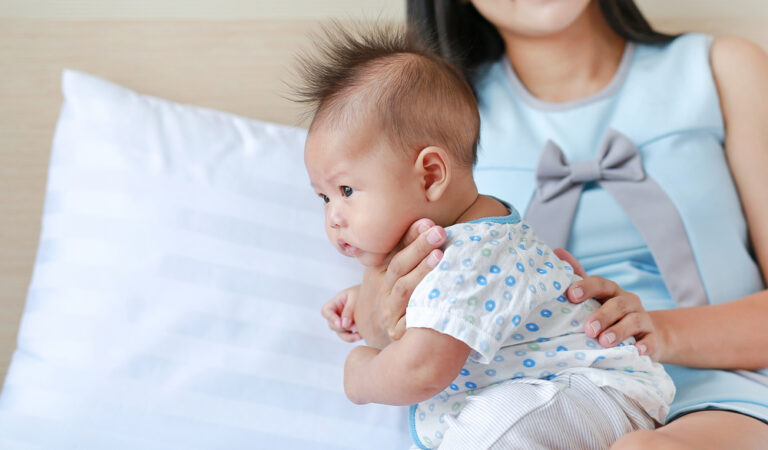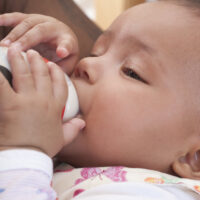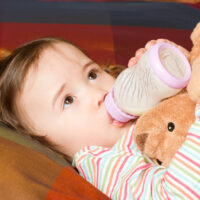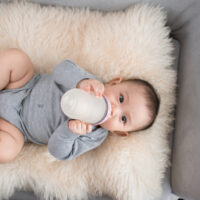Remembering to burp your baby when they’re done helps get the air out of the digestive tract. When the air comes out as a burp, it’s less likely to cause gas bubbles in the digestive tract. Unfortunately, some babies take more than a few pats on the back to get that trapped air to come out. Below, you’ll find advice on how to burp a baby who is hard to burp so you can get your little one feeling better.
Try Different Positions
Sometimes, getting your baby to burp is as easy as finding the right position to burp them in. Something to note is that even if your baby typically prefers a specific position, switching moves your baby around. Just choosing a different position might help the air bubbles travel up so they can more easily be expelled. Here are some methods you can try.
Over-the-Shoulder
In a more traditional burping position, caregivers usually hold baby up. The baby is against their chest and their baby’s chin is resting on their shoulder. Then, gently patting against the back might help. It might also help to sit in a rocking chair while you do this- sometimes the back and forth movement cause the trapped air bubbles to move around. This may make it easier to burp your baby.
An alternative to this position is placing your baby farther up on your shoulder. Their chest should be on top of your shoulder and their head should be leaning over your back. Lean forward slightly while doing this so your baby remains upright during burping. It’s also best to do this while your baby already has some control of its head and neck.
While They Are Sitting
You could also try to burp your baby while they are sitting up. You can prop them against your knee if you put that up or against your chest while they are on your lap. To provide good support, you’re going to cup your baby’s chin (not their throat) in your hand. Pat your baby’s back with the opposite hand.
Over-the-Knees
Another position that you could try is lying your baby down. You want them laying down on their stomach. This usually works best when you lay your baby across your knees. You can lay them across or you can let your baby straddle one (or both) of your thighs. Be sure your baby’s head is higher than their chest and pat them gently on the back. Rubbing your baby’s back might work better for this since you can easily push the air bubbles around.
The Football Hold
Finally, you can try to burp your baby in the football hold position. In this position, you’re going to place your baby on one of your forearms, between your wrist and elbow. They should be laying on their belly with their head toward your elbow. As you hold your baby in place, gently pat or rub on their back to try and expel any trapped air.
Wait Five Minutes
Sometimes, your baby’s digestive system might need time for the air bubbles to move around. If burping right away doesn’t work, try letting your baby be still. You can lay them down, however, some babies are more likely to spit up after feeding if you lay them down right away. After waiting five minutes, try burping your baby again.
Try Rubbing Instead of Patting
Using a rubbing motion on the back instead of patting works better for some babies, too. When you pat, you’re usually targeting a specific area. By rubbing instead, you’re physically pushing the air bubbles around. You may find that there’s a specific motion of rubbing that is also more effective. Some babies respond better to pushing the air with an upward, straight motion while others might do better if you make circles on their back.
Gently Bounce or Rock Your Baby
Sometimes, a gentle bouncing motion may help your baby burp. Hold your baby against your chest and provide support for their head and neck. Walk with your baby as you gently bounce them. You could also lay your baby across your lap on their stomach as you gently bounce them. Of course, you should be careful not to bounce your little one too vigorously- too much bouncing may cause spit-up.
Rocking your baby may also help. When you are moving them back and forth, the air bubbles have a better chance to move around. Since the body naturally expels gas, moving the bubbles to where they need to go makes it easier for your baby to burp.
RELATED: The Best Burp Cloths
Consider Burping Exercises
Burping exercises are simple movements that you can use to naturally expel gas from your baby’s belly. There are several different movements you can try.
Elbow-to-Knee
The elbow-to-knee movement is great for expelling any gas in your baby’s digestive tract. While it doesn’t always work for burping, you may be able to get your baby to pass gas the other way.
Lay your baby on their back on a flat, sturdy surface. Gently hold your baby’s left knee and right elbow, bringing them both toward the chest like you would if you were going to make them touch. You don’t have to make them touch completely, especially if it doesn’t feel natural. Then, repeat on the opposite side.
Forward and Backward
Start by setting your baby up in your lap, supporting their head and neck the same way you would if you were burping them. Slowly lean your baby forward, holding the position for a few seconds. Then, slowly move your baby backward, as if you were going to lay them down. Hold this for a few seconds and return to an upright position. Do this several times until your baby burps.
Rotations
To do rotations, have your baby sit upright with head support like you would when doing the forward and backward technique. Support your baby’s head and neck while you slowly rotate their body by making clockwise circles at the waist. After several rotations, slowly rotate them counterclockwise instead.
Belly Massage
It can also be helpful to massage your baby’s belly. Lay your baby flat on their back. Then, make small, circular motions with the palm of your hand or several fingertips. Try not to put too much pressure on your baby’s tummy. You want just enough that it moves the air in their stomach around.
You can move in a clockwise or counterclockwise motion. You can even go one way and then switch after a minute two. Pay attention to how your baby is reacting to the movements and let that guide your hands.
Avoid doing this technique right after feeding, especially if your baby has reflux or GERD, digestive problems, or spits up easily. Instead, wait at least 10-15 minutes after feeding so your baby is less likely to spit up.
Check Your Feeding Position
Air is heavier than liquid, so it’s going to rise naturally in your baby’s digestive tract. When feeding, you should always keep your baby’s head positioned higher than their chest. This lets air rise when it’s swallowed, making it easier to burp your baby later. Since the milk/formula will naturally go down as well, your baby also swallows less air when they’re in a better feeding position.
This doesn’t mean you have to sit your baby up while they eat. While keeping them upright is an option, you can still lay them down as long as you prop their head up slightly. You should avoid feeding your baby when they are completely flat.
Ensure Your Baby Isn’t Taking in Excess Air
Something else that helps prevent uncomfortable air in the digestive tract is monitoring how your baby feeds and readjusting as necessary. You’ll know that your baby is taking in extra air if they are gulping instead of swallowing.
Preventing Air Intake While Breastfeeding
For breastfed babies, you’ll want to be sure that your baby is latched properly. If your baby is latched properly, you shouldn’t have any pain. It should be clear that they are swallowing and their mouth should be latched around your breast, not just the nipple. Many hospitals have a lactation consultant on staff so you can be sure your little one is latching properly before coming home. You can learn more about signs of a good latch here.
Something else to keep in mind is that your baby is likely to feed faster (and swallow more air) if your breasts are engorged. You can try expressing a little milk beforehand so the letdown isn’t so strong if your baby is having problems.
RELATED: The Best Bottles for Breastfeeding
Preventing Air Intake While Bottle Feeding
For babies that are bottle-fed, you’ll want to be sure that the nipple doesn’t have a hole that is too big in it. A good test is to put the cold formula in it and turn the bottle upside down. It shouldn’t drip at a rate faster than one drop per second. The nipple should also be soft enough that it contours to your baby’s lips, creating a seal so that air doesn’t get through.
It’s also important to hold the bottle at the right angle for feeding. There is going to be air in the bottle with the formula. You’ll need to angle it so that only the formula is getting into the nipple.
Consider Other Causes of Gas
Sometimes, your baby has gas for reasons other than swallowing air. There are several common reasons that babies might have excessive burping or gas, including food digestion.
Your Baby’s Diet
Babies that are formula-fed might have trouble with a specific brand of food. They do make formula for gassy babies and babies with sensitive tummies, though. If you do suspect an allergy or want to switch brands, it’s best to consult with your pediatrician first. It can also take time for your baby to adjust to a formula change, especially if you are switching main ingredients (for example, from a dairy to a soy formula).
Even exclusively breastfed babies may experience gassiness from their diet. If your baby has a food sensitivity to gluten or dairy, they may experience digestive problems if you eat more of these products than normal. Cruciferous vegetables like cauliflower and kale may also be the culprit. If you think your diet might be the problem, keep a diary of what you eat and look for patterns that correspond with your baby’s symptoms.
Excessive Crying
If your baby has colic or gets fussy a lot, they may be swallowing a lot of air while they cry. All this excessive air gets trapped in the digestive tract and causes more fussiness. Burping your baby after a cry (even if they haven’t eaten) might help calm them down.
Food Sensitivity
If you have introduced solids, there is also a risk of food sensitivities. Some common indicators of mild food sensitivity include diaper rash, loose stools or constipation, or excessive gassiness. Since your baby’s digestive tract is still immature, it’s very possible that they will outgrow the food sensitivity as they get older. You can try it again several months later if you aren’t sure.
FAQs – How to Burp a Baby Who is Hard to Burp
Is it okay to skip burping if my baby falls asleep?
Even if your baby falls asleep while eating, you shouldn’t skip burping them. It’s very tempting to skip if your baby is already sleeping peacefully. However, if you don’t burp them, your baby is likely to wake up from gas pain or possibly even spit-up. This will disturb their ability to sleep anyway, so it’s best to gently burp them before you put them back to sleep.
The best way to get your baby to burp while sleeping is by gently rubbing or patting their back. This is easiest to do while they are laying on their stomach, but you can also keep them resting against your shoulder or in another position to burp them.
Why is it harder to burp my baby at night?
Babies may swallow less air at night during feedings. Since your baby is more relaxed, they aren’t eating as quickly. Without gulping down formula/milk, your baby also isn’t swallowing as much air. Since there isn’t as much air, they may not need to burp at all after a nighttime feeding. However, it’s best to at least try burping them to prevent any issues that might wake them up.
How often do I need to burp my baby?
Bottle-fed babies should be burped every 2-3 ounces and breastfed babies should be burped when you switch breasts. You should also burp your baby after feeding. While you should try to burp your baby, you shouldn’t force it. If they don’t burp after trying for a few minutes, continue feeding them instead.
Breastfed babies might not need to be burped as frequently as babies that take a bottle. This is because bottles have air in them, while the breast does not. However, when babies are especially hungry or the mother has a fast letdown, it’s more likely that they will swallow air and need to burp.
It’s important that even if your baby isn’t acting fussy, you still try to burp them. You can’t tell how much air is swallowed during eating. However, burping your baby gives them a chance to release some of this air and it only takes a couple of minutes.
You should also burp your baby once they’ve finished feeding or if it seems they are pulling away or fussy while feeding. Your baby becoming fussy or pulling away may indicate they have air upsetting their digestive tract.
Something to remember is that all babies are different. Pay attention to your baby’s cues and how often they typically need to be burped. Once you recognize patterns or habits, you’ll know when to burp them.
When can I stop burping my baby?
Babies need to burp because their immature digestive tract doesn’t always push air out, which causes discomfort. Generally, babies stop needing to be burped between 4 and 6 months of age. However, some babies may continue having digestive problems up to 9 months of age. Pay attention to your little one’s needs. If they regularly don’t need to be burped any longer after a feeding, then you can stop burping them.
Final Word
By now, you should have a few ideas of how to burp a baby who is hard to burp. Burping your baby is important for removing gas from the digestive tract and avoiding stomach upset. With so many methods to try, the best thing you can do is be persistent. Your baby will burp eventually and it should become easier once you learn what burping method works best.






